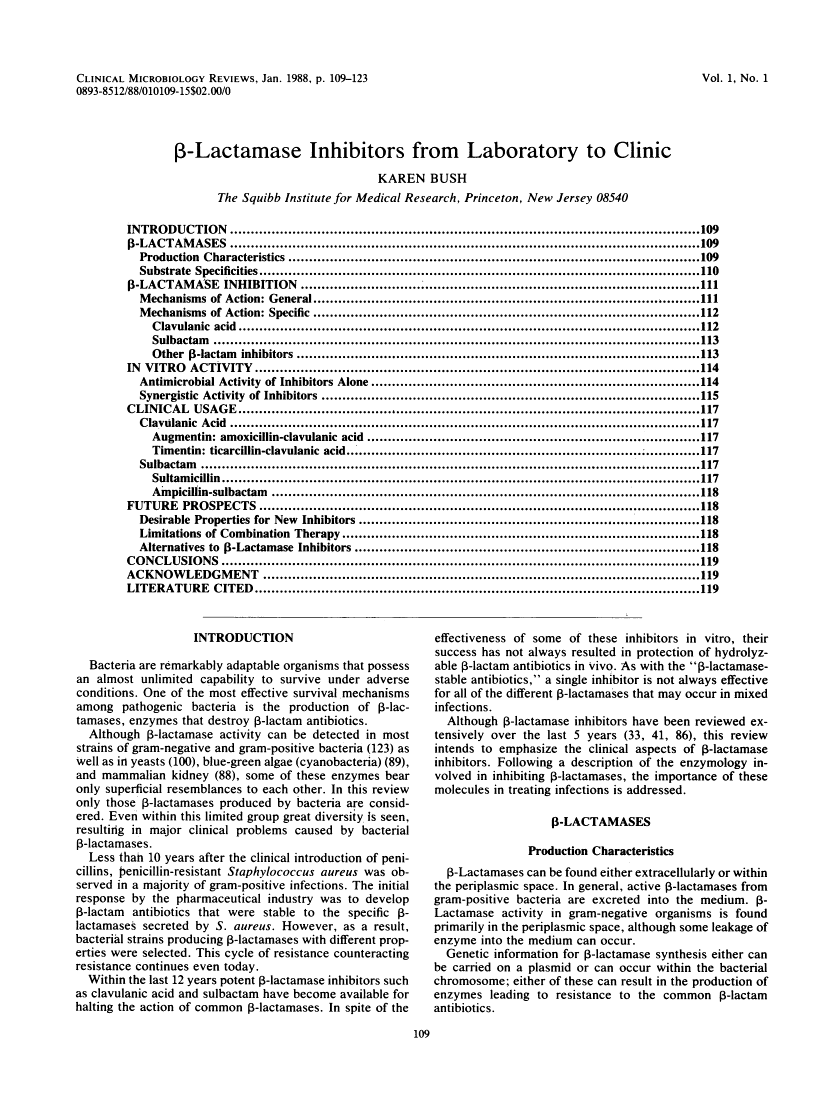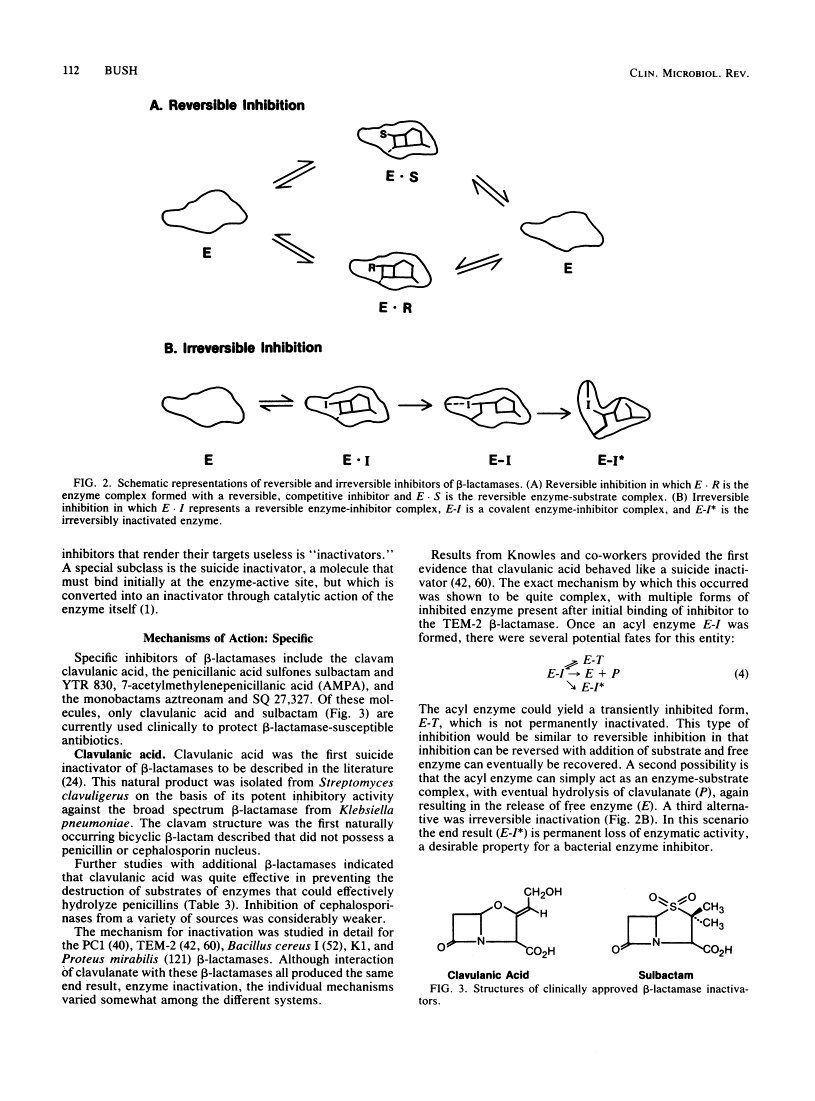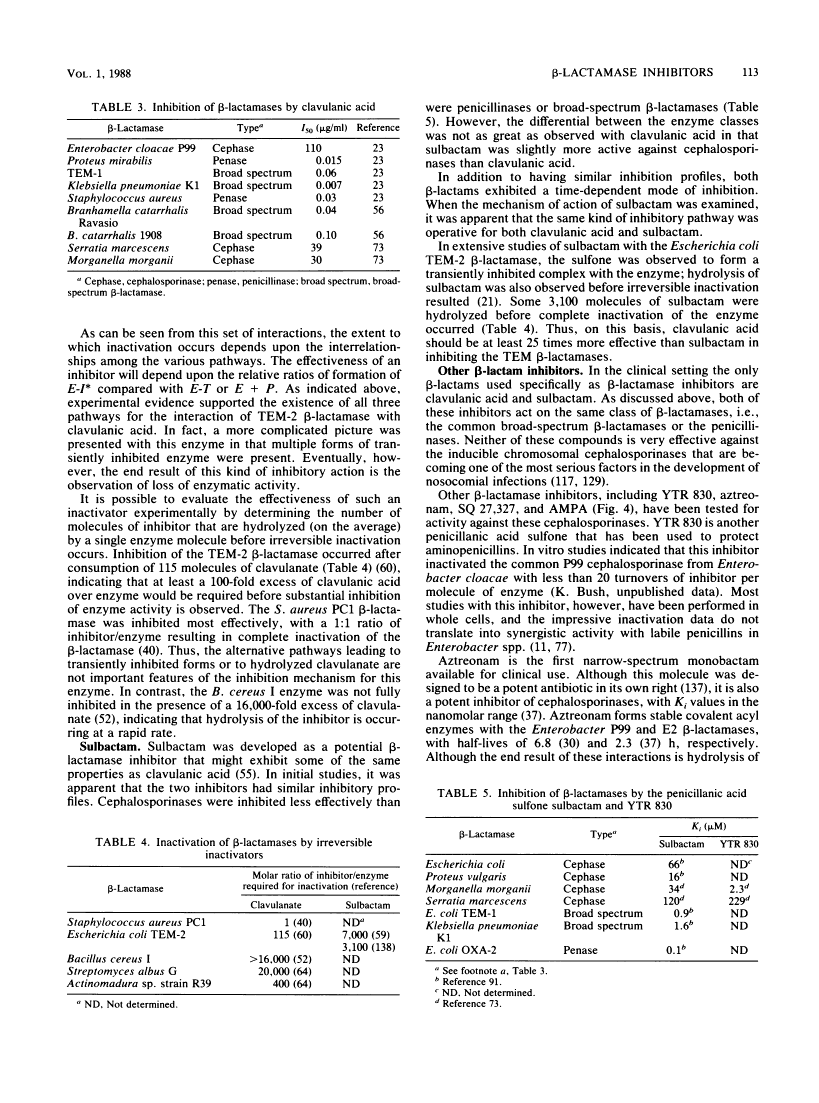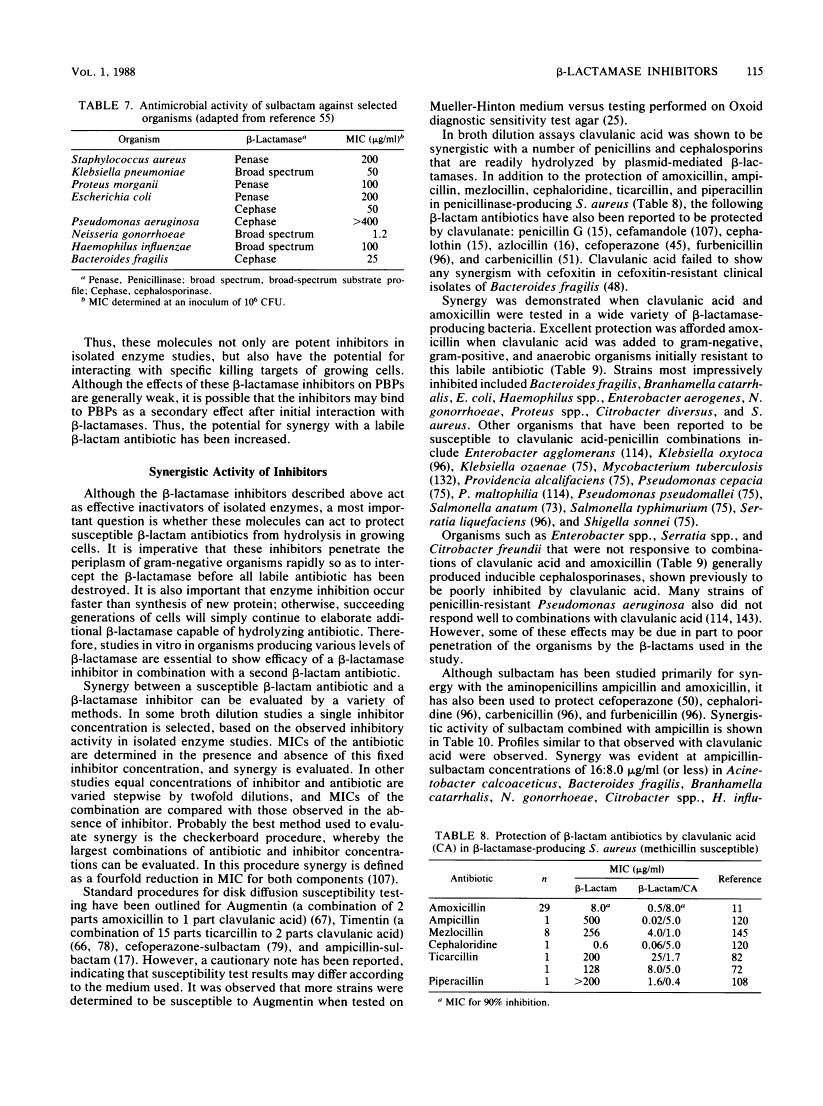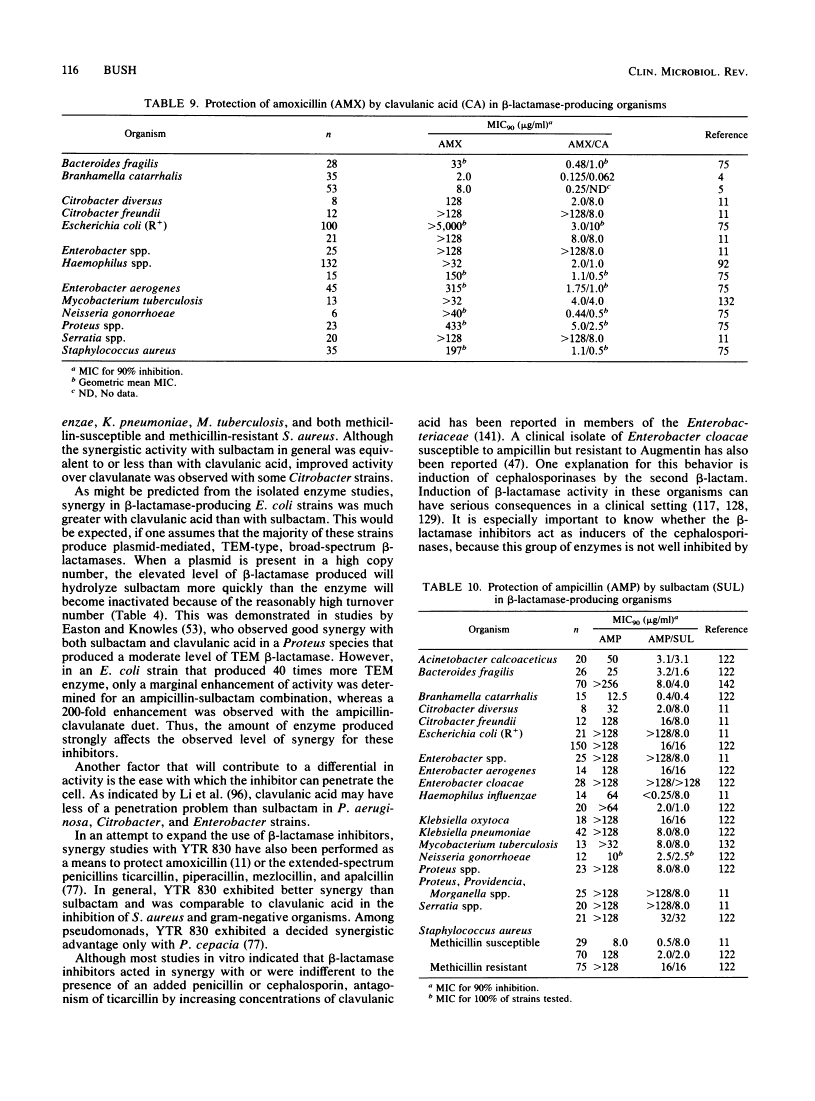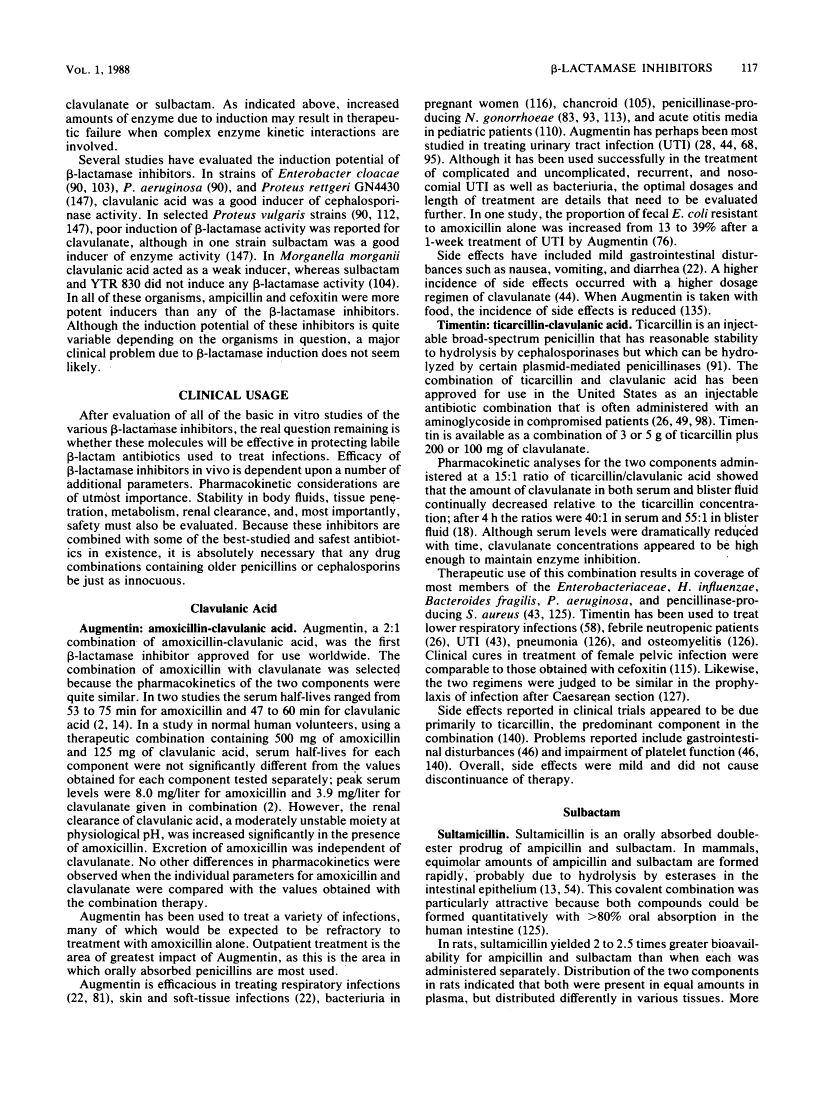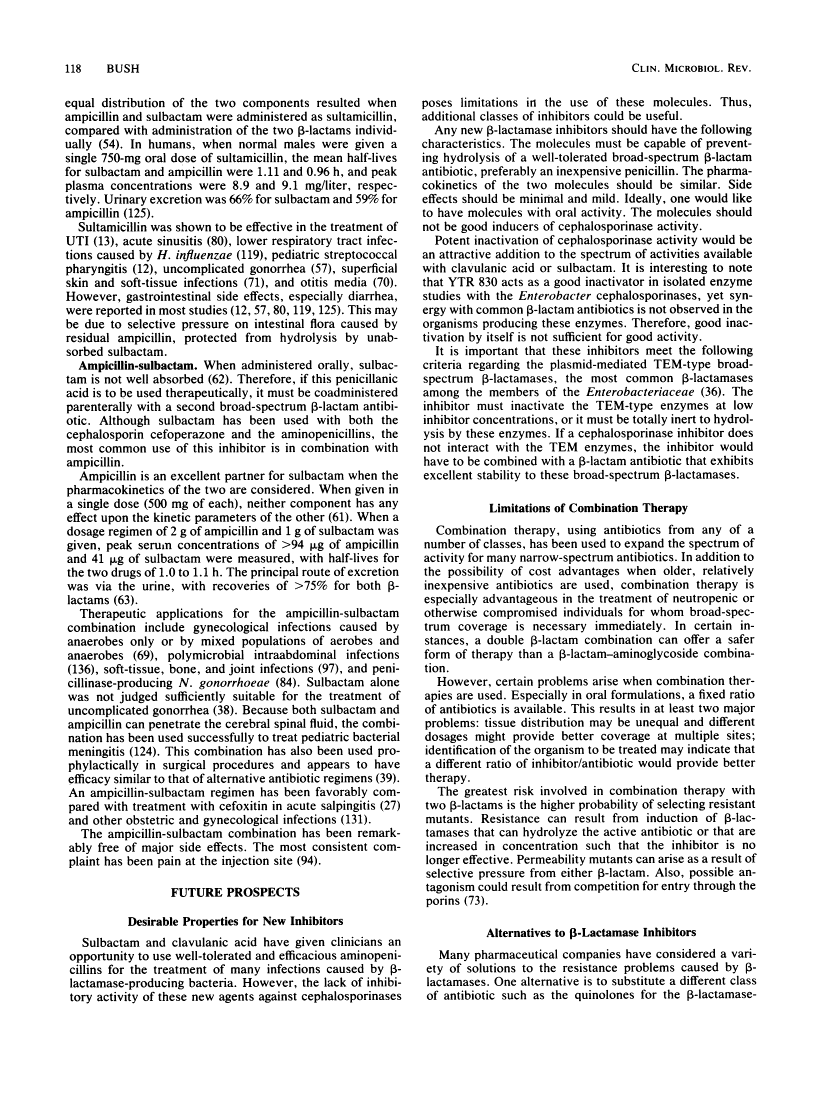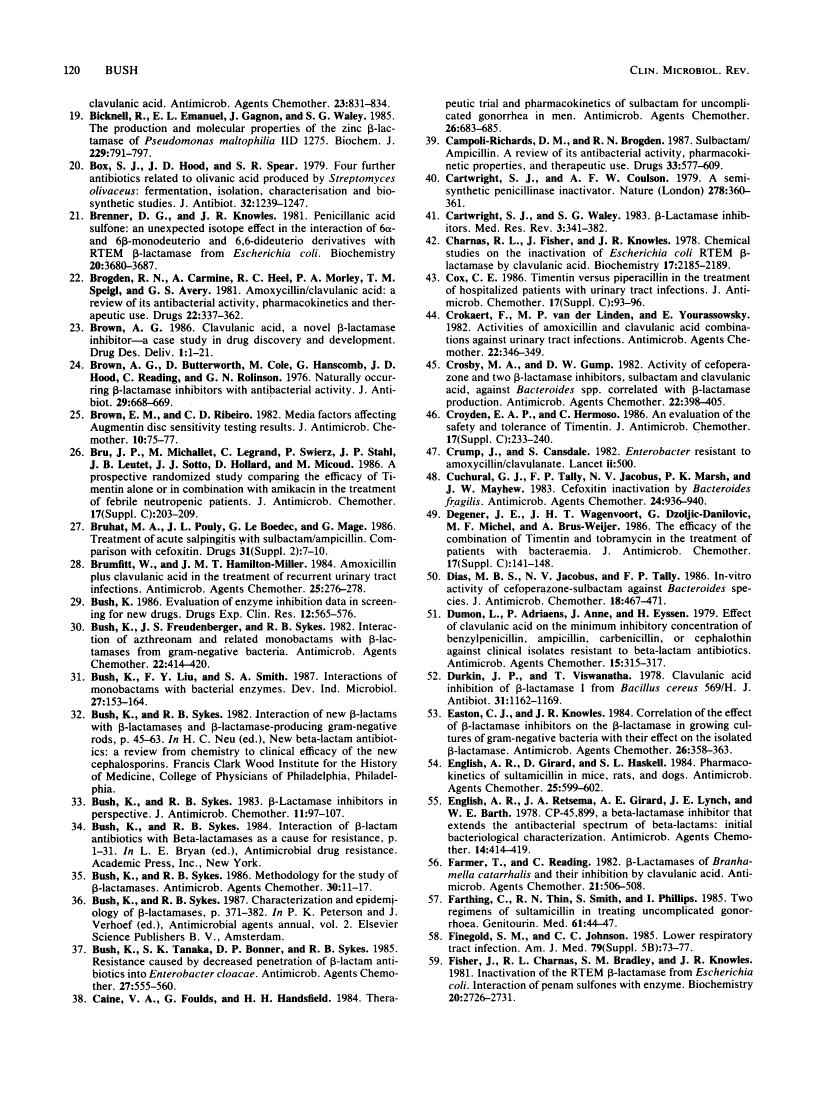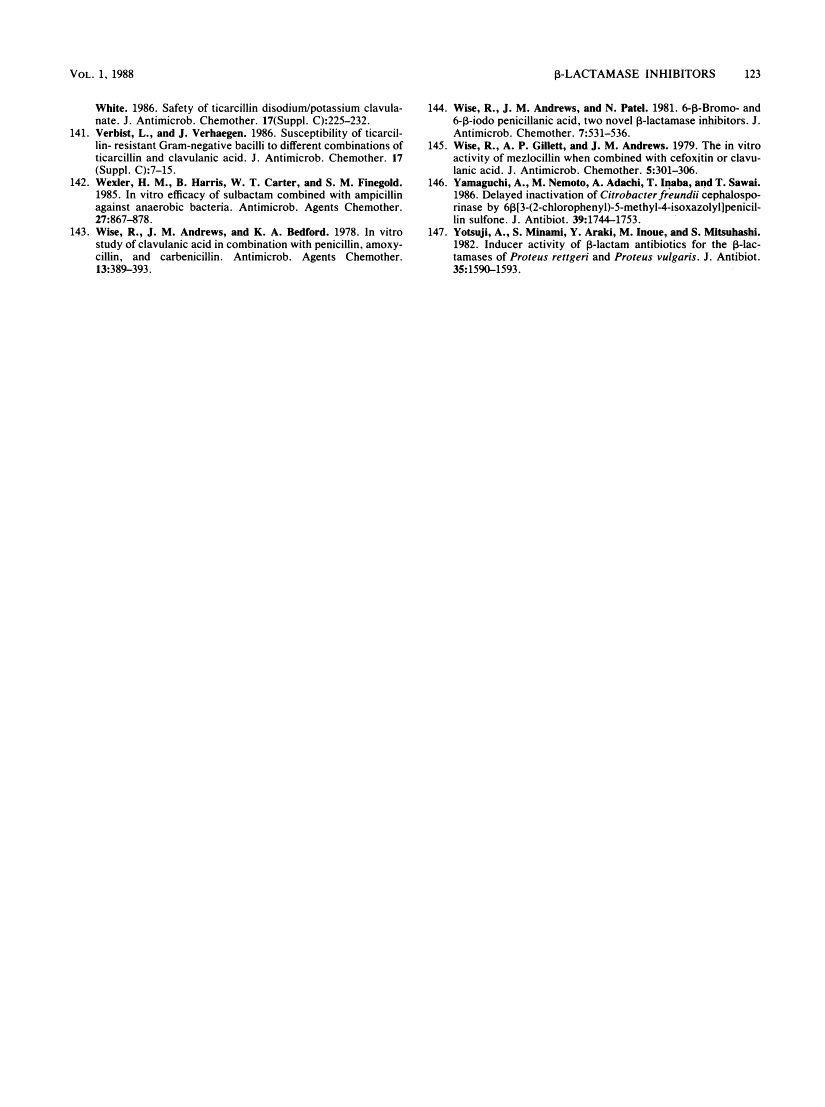Abstract
Free full text

Beta-lactamase inhibitors from laboratory to clinic.
Abstract
beta-Lactamases constitute the major defense mechanism of pathogenic bacteria against beta-lactam antibiotics. When the beta-lactam ring of this antibiotic class is hydrolyzed, antimicrobial activity is destroyed. Although beta-lactamases have been identified with clinical failures for over 40 years, enzymes with various abilities to hydrolyze specific penicillins or cephalosporins are appearing more frequently in clinical isolates. One approach to counteracting this resistance mechanism has been through the development of beta-lactamase inactivators. beta-Lactamase inhibitors include clavulanic acid and sulbactam, molecules with minimal antibiotic activity. However, when combined with safe and efficacious penicillins or cephalosporins, these inhibitors can serve to protect the familiar beta-lactam antibiotics from hydrolysis by penicillinases or broad-spectrum beta-lactamases. Both of these molecules eventually inactivate the target enzymes permanently. Although clavulanic acid exhibits more potent inhibitory activity than sulbactam, especially against the TEM-type broad-spectrum beta-lactamases, the spectrum of inhibitory activities are very similar. Neither of these inhibitors acts as a good inhibitor of the cephalosporinases. Clavulanic acid has been most frequently combined with amoxicillin in the orally active Augmentin and with ticarcillin in the parenteral beta-lactam combination Timentin. Sulbactam has been used primarily to protect ampicillin from enzymatic hydrolysis. Sulbactam has been used either in the orally absorbed prodrug form as sultamicillin or as the injectable combination ampicillin-sulbactam. Synergy has been demonstrated for these combinations for most members of the Enterobacteriaceae, although those organisms that produce cephalosporinases are not well inhibited. Synergy has also been observed for Neisseria gonorrhoeae, Haemophilus influenzae, penicillinase-producing Staphylococcus aureus, and anaerobic organisms. These antibiotic combinations have been used clinically to treat urinary tract infections, bone and soft-tissue infections, gonorrhea, respiratory infections, and otitis media. Gastrointestinal side effects have been reported for Augmentin and sultamicillin; most side effects with these agents have been mild. Although combination therapy with beta-lactamase inactivators has been used successfully, the problem of resistance development to two agents must be considered. Induction of cephalosporinases can occur with clavulanic acid. Permeability mutants could arise, especially with added pressure from a second beta-lactam.(ABSTRACT TRUNCATED AT 250 WORDS)
Full text
Full text is available as a scanned copy of the original print version. Get a printable copy (PDF file) of the complete article (2.7M), or click on a page image below to browse page by page. Links to PubMed are also available for Selected References.
Selected References
These references are in PubMed. This may not be the complete list of references from this article.
- Adam D, de Visser I, Koeppe P. Pharmacokinetics of amoxicillin and clavulanic acid administered alone and in combination. Antimicrob Agents Chemother. 1982 Sep;22(3):353–357. [Europe PMC free article] [Abstract] [Google Scholar]
- Adam S, Then RL, Angehrn P. 6-(E)-acetylmethylenepenicillanic acid, a potent beta-lactamase inhibitor. J Antibiot (Tokyo) 1987 Jan;40(1):108–109. [Abstract] [Google Scholar]
- Ahmad F, McLeod DT, Croughan MJ, Calder MA. Antimicrobial susceptibility of Branhamella catarrhalis isolates from bronchopulmonary infections. Antimicrob Agents Chemother. 1984 Sep;26(3):424–425. [Europe PMC free article] [Abstract] [Google Scholar]
- Alvarez S, Jones M, Holtsclaw-Berk S, Guarderas J, Berk SL. In vitro susceptibilities and beta-lactamase production of 53 clinical isolates of Branhamella catarrhalis. Antimicrob Agents Chemother. 1985 Apr;27(4):646–647. [Europe PMC free article] [Abstract] [Google Scholar]
- Ambler RP. The structure of beta-lactamases. Philos Trans R Soc Lond B Biol Sci. 1980 May 16;289(1036):321–331. [Abstract] [Google Scholar]
- Angehrn P, Arisawa M. 6-Acetylmethylenepenicillanic acid (Ro 15-1903), a potent beta-lactamase inhibitor. II. Antibacterial properties. J Antibiot (Tokyo) 1982 Nov;35(11):1584–1589. [Abstract] [Google Scholar]
- Arisawa M, Adam S. Mechanism of inactivation of TEM-1 beta-lactamase by 6-acetylmethylenepenicillanic acid. Biochem J. 1983 May 1;211(2):447–454. [Europe PMC free article] [Abstract] [Google Scholar]
- Arisawa M, Then RL. 6-Acetylmethylenepenicillanic acid (Ro 15-1903), a potent beta-lactamase inhibitor. I. Inhibition of chromosomally and R-factor-mediated beta-lactamases. J Antibiot (Tokyo) 1982 Nov;35(11):1578–1583. [Abstract] [Google Scholar]
- Arisawa M, Then R. Inactivation of TEM-1 beta-lactamase by 6-acetylmethylenepenicillanic acid. Biochem J. 1983 Mar 1;209(3):609–615. [Europe PMC free article] [Abstract] [Google Scholar]
- Aronoff SC, Jacobs MR, Johenning S, Yamabe S. Comparative activities of the beta-lactamase inhibitors YTR 830, sodium clavulanate, and sulbactam combined with amoxicillin or ampicillin. Antimicrob Agents Chemother. 1984 Oct;26(4):580–582. [Europe PMC free article] [Abstract] [Google Scholar]
- Aronoff SC, Klinger JD, O'Brien CA, Jaffe AC, Blumer JL. A double-blinded comparative study of sultamicillin and potassium penicillin V in the treatment of childhood streptococcal pharyngitis. J Antimicrob Chemother. 1984 Sep;14(3):261–265. [Abstract] [Google Scholar]
- Ball AP, Fox C, Ghosh D. Sultamicillin (CP-49, 952): evaluation of two dosage schedules in urinary infection. J Antimicrob Chemother. 1984 Oct;14(4):395–401. [Abstract] [Google Scholar]
- Ball AP, Geddes AM, Davey PG, Farrell ID, Brookes GR. Clavulanic acid and amoxycillin: a clinical, bacteriological, and pharmacological study. Lancet. 1980 Mar 22;1(8169):620–623. [Abstract] [Google Scholar]
- Bansal MB, Chuah SK, Oryema-Lalobo M, Thadepalli H. Augmentation effect of clavulanic acid with penicillin, cephalothin and ticarcillin against Bacteroides fragilis. Chemotherapy. 1985;31(3):173–177. [Abstract] [Google Scholar]
- Bansal MB, Chuah SK, Thadepalli H. Augmentation of the in vitro activity of azlocillin against Bacteroides fragilis by clavulanic acid. Antimicrob Agents Chemother. 1984 Oct;26(4):606–607. [Europe PMC free article] [Abstract] [Google Scholar]
- Barry AL, Jones RN, Thornsberry C. Interpretive standards and quality control limits for susceptibility tests with ampicillin-sulbactam combination disks. J Clin Microbiol. 1984 Feb;19(2):134–139. [Europe PMC free article] [Abstract] [Google Scholar]
- Bicknell R, Emanuel EL, Gagnon J, Waley SG. The production and molecular properties of the zinc beta-lactamase of Pseudomonas maltophilia IID 1275. Biochem J. 1985 Aug 1;229(3):791–797. [Europe PMC free article] [Abstract] [Google Scholar]
- Box SJ, Hood JD, Spear SR. Four further antibiotics related to olivanic acid produced by Streptomyces olivaceus: fermentation, isolation, characterisation and biosynthetic studies. J Antibiot (Tokyo) 1979 Dec;32(12):1239–1247. [Abstract] [Google Scholar]
- Brenner DG, Knowles JR. Penicillanic acid sulfone: an unexpected isotope effect in the interaction of 6 alpha- and 6 beta-monodeuterio and of 6,6-dideuterio derivatives with RTEM beta-lactamase from Escherichia coli. Biochemistry. 1981 Jun 23;20(13):3680–3687. [Abstract] [Google Scholar]
- Brogden RN, Carmine A, Heel RC, Morley PA, Speight TM, Avery GS. Amoxycillin/clavulanic acid: a review of its antibacterial activity, pharmacokinetics and therapeutic use. Drugs. 1981 Nov;22(5):337–362. [Abstract] [Google Scholar]
- Brown AG. Clavulanic acid, a novel beta-lactamase inhibitor--a case study in drug discovery and development. Drug Des Deliv. 1986 Aug;1(1):1–21. [Abstract] [Google Scholar]
- Brown AG, Butterworth D, Cole M, Hanscomb G, Hood JD, Reading C, Rolinson GN. Naturally-occurring beta-lactamase inhibitors with antibacterial activity. J Antibiot (Tokyo) 1976 Jun;29(6):668–669. [Abstract] [Google Scholar]
- Brown EM, Ribeiro CD. Media factors affecting Augmentin disc sensitivity testing results. J Antimicrob Chemother. 1982 Jul;10(1):75–77. [Abstract] [Google Scholar]
- Bru JP, Michallet M, Legrand C, Swierz P, Stahl JP, Leautet JB, Sotto JJ, Hollard D, Micoud M. A prospective randomized study comparing the efficacy of Timentin alone or in combination with amikacin in the treatment of febrile neutropenic patients. J Antimicrob Chemother. 1986 May;17 (Suppl 100):203–209. [Abstract] [Google Scholar]
- Bruhat MA, Pouly JL, Le Boedec G, Mage G. Treatment of acute salpingitis with sulbactam/ampicillin. Comparison with cefoxitin. Drugs. 1986;31 (Suppl 2):7–10. [Abstract] [Google Scholar]
- Brumfitt W, Hamilton-Miller JM. Amoxicillin plus clavulanic acid in the treatment of recurrent urinary tract infections. Antimicrob Agents Chemother. 1984 Feb;25(2):276–278. [Europe PMC free article] [Abstract] [Google Scholar]
- Bush K. Evaluation of enzyme inhibition data in screening for new drugs. Drugs Exp Clin Res. 1986;12(6-7):565–576. [Abstract] [Google Scholar]
- Bush K, Freudenberger JS, Sykes RB. Interaction of azthreonam and related monobactams with beta-lactamases from gram-negative bacteria. Antimicrob Agents Chemother. 1982 Sep;22(3):414–420. [Europe PMC free article] [Abstract] [Google Scholar]
- Bush K, Sykes RB. beta-Lactamase inhibitors in perspective. J Antimicrob Chemother. 1983 Feb;11(2):97–107. [Abstract] [Google Scholar]
- Ohm-Smith MJ, Sweet RL, Hadley WK. Occurrence of clindamycin-resistant anaerobic bacteria isolated from cultures taken following clindamycin therapy. Antimicrob Agents Chemother. 1986 Jul;30(1):11–14. [Europe PMC free article] [Abstract] [Google Scholar]
- Bush K, Tanaka SK, Bonner DP, Sykes RB. Resistance caused by decreased penetration of beta-lactam antibiotics into Enterobacter cloacae. Antimicrob Agents Chemother. 1985 Apr;27(4):555–560. [Europe PMC free article] [Abstract] [Google Scholar]
- Caine VA, Foulds G, Handsfield HH. Therapeutic trial and pharmacokinetics of sulbactam for uncomplicated gonorrhea in men. Antimicrob Agents Chemother. 1984 Nov;26(5):683–685. [Europe PMC free article] [Abstract] [Google Scholar]
- Campoli-Richards DM, Brogden RN. Sulbactam/ampicillin. A review of its antibacterial activity, pharmacokinetic properties, and therapeutic use. Drugs. 1987 Jun;33(6):577–609. [Abstract] [Google Scholar]
- Cartwright SJ, Coulson AF. A semi-synthetic penicillinase inactivator. Nature. 1979 Mar 22;278(5702):360–361. [Abstract] [Google Scholar]
- Cartwright SJ, Waley SG. beta-Lactamase inhibitors. Med Res Rev. 1983 Oct-Dec;3(4):341–382. [Abstract] [Google Scholar]
- Charnas RL, Fisher J, Knowles JR. Chemical studies on the inactivation of Escherichia coli RTEM beta-lactamase by clavulanic acid. Biochemistry. 1978 May 30;17(11):2185–2189. [Abstract] [Google Scholar]
- Cox CE. Timentin versus piperacillin in the treatment of hospitalized patients with urinary tract infections. J Antimicrob Chemother. 1986 May;17 (Suppl 100):93–96. [Abstract] [Google Scholar]
- Crokaert F, van der Linden MP, Yourassowsky E. Activities of amoxicillin and clavulanic acid combinations against urinary tract infections. Antimicrob Agents Chemother. 1982 Aug;22(2):346–349. [Europe PMC free article] [Abstract] [Google Scholar]
- Crosby MA, Gump DW. Activity of cefoperazone and two beta-lactamase inhibitors, sulbactam and clavulanic acid, against Bacteroides spp. correlated with beta-lactamase production. Antimicrob Agents Chemother. 1982 Sep;22(3):398–405. [Europe PMC free article] [Abstract] [Google Scholar]
- Croydon EA, Hermoso C. An evaluation of the safety and tolerance of Timentin. J Antimicrob Chemother. 1986 May;17 (Suppl 100):233–240. [Abstract] [Google Scholar]
- Crump J, Cansdale S. Enterobacter resistant to amoxycillin/clavulanate. Lancet. 1982 Aug 28;2(8296):500–500. [Abstract] [Google Scholar]
- Cuchural GJ, Jr, Tally FP, Jacobus NV, Marsh PK, Mayhew JW. Cefoxitin inactivation by Bacteroides fragilis. Antimicrob Agents Chemother. 1983 Dec;24(6):936–940. [Europe PMC free article] [Abstract] [Google Scholar]
- Degener JE, Wagenvoort JH, Dzoljic-Danilovic G, Michel MF, Brus-Weijer A. The efficacy of the combination of Timentin and tobramycin in the treatment of patients with bacteraemia. J Antimicrob Chemother. 1986 May;17 (Suppl 100):141–148. [Abstract] [Google Scholar]
- Souza Dias MB, Jacobus NV, Tally FP. In-vitro activity of cefoperazone-sulbactam against Bacteroides species. J Antimicrob Chemother. 1986 Oct;18(4):467–471. [Abstract] [Google Scholar]
- Dumon L, Adriaens P, Anné J, Eyssen H. Effect of clavulanic acid on the minimum inhibitory concentration of benzylpenicillin, ampicillin, carbenicillin, or cephalothin against clinical isolates resistant to beta-lactam antibiotics. Antimicrob Agents Chemother. 1979 Feb;15(2):315–317. [Europe PMC free article] [Abstract] [Google Scholar]
- Durkin JP, Viswanatha T. Clavulanic acid inhibition of beta-lactamase I from Bacillus cereus 569/H. J Antibiot (Tokyo) 1978 Nov;31(11):1162–1169. [Abstract] [Google Scholar]
- Easton CJ, Knowles JR. Correlation of the effect of beta-lactamase inhibitors on the beta-lactamase in growing cultures of gram-negative bacteria with their effect on the isolated beta-lactamase. Antimicrob Agents Chemother. 1984 Sep;26(3):358–363. [Europe PMC free article] [Abstract] [Google Scholar]
- English AR, Girard D, Haskell SL. Pharmacokinetics of sultamicillin in mice, rats, and dogs. Antimicrob Agents Chemother. 1984 May;25(5):599–602. [Europe PMC free article] [Abstract] [Google Scholar]
- English AR, Retsema JA, Girard AE, Lynch JE, Barth WE. CP-45,899, a beta-lactamase inhibitor that extends the antibacterial spectrum of beta-lactams: initial bacteriological characterization. Antimicrob Agents Chemother. 1978 Sep;14(3):414–419. [Europe PMC free article] [Abstract] [Google Scholar]
- Farmer T, Reading C. beta-Lactamases of Branhamella catarrhalis and their inhibition by clavulanic acid. Antimicrob Agents Chemother. 1982 Mar;21(3):506–508. [Europe PMC free article] [Abstract] [Google Scholar]
- Farthing C, Thin RN, Smith S, Phillips I. Two regimens of sultamicillin in treating uncomplicated gonorrhoea. Genitourin Med. 1985 Feb;61(1):44–47. [Europe PMC free article] [Abstract] [Google Scholar]
- Finegold SM, Johnson CC. Lower respiratory tract infection. Am J Med. 1985 Nov 29;79(5B):73–77. [Abstract] [Google Scholar]
- Fisher J, Charnas RL, Bradley SM, Knowles JR. Inactivation of the RTEM beta-lactamase from Escherichia coli. Interaction of penam sulfones with enzyme. Biochemistry. 1981 May 12;20(10):2726–2731. [Abstract] [Google Scholar]
- Fisher J, Charnas RL, Knowles JR. Kinetic studies on the inactivation of Escherichia coli RTEM beta-lactamase by clavulanic acid. Biochemistry. 1978 May 30;17(11):2180–2184. [Abstract] [Google Scholar]
- Foulds G. Pharmacokinetics of sulbactam/ampicillin in humans: a review. Rev Infect Dis. 1986 Nov-Dec;8 (Suppl 5):S503–S511. [Abstract] [Google Scholar]
- Foulds G, Stankewich JP, Marshall DC, O'Brien MM, Hayes SL, Weidler DJ, McMahon FG. Pharmacokinetics of sulbactam in humans. Antimicrob Agents Chemother. 1983 May;23(5):692–699. [Europe PMC free article] [Abstract] [Google Scholar]
- Frère JM, Dormans C, Lenzini VM, Duyckaerts C. Interaction of clavulanate with the beta-lactamases of Streptomyces albus G and Actinomadura R39. Biochem J. 1982 Dec 1;207(3):429–436. [Europe PMC free article] [Abstract] [Google Scholar]
- Frère JM, Joris B. Penicillin-sensitive enzymes in peptidoglycan biosynthesis. Crit Rev Microbiol. 1985;11(4):299–396. [Abstract] [Google Scholar]
- Fuchs PC, Barry AL, Jones RN. In vitro activity and disk susceptibility of Timentin: current status. Am J Med. 1985 Nov 29;79(5B):25–32. [Abstract] [Google Scholar]
- Fuchs PC, Barry AL, Thornsberry C, Gavan TL, Jones RN. In vitro evaluation of Augmentin by broth microdilution and disk diffusion susceptibility testing: regression analysis, tentative interpretive criteria, and quality control limits. Antimicrob Agents Chemother. 1983 Jul;24(1):31–38. [Europe PMC free article] [Abstract] [Google Scholar]
- Gasser TC, Larsen EH, Madsen PO. Amoxicillin/clavulanate in urinary tract infection. Urology. 1987 Jan;29(1):111–114. [Abstract] [Google Scholar]
- Giamarellou H, Trouvas G, Avlami A, Aravantinos D, Daikos GK. Efficacy of sulbactam plus ampicillin in gynecologic infections. Rev Infect Dis. 1986 Nov-Dec;8 (Suppl 5):S579–S582. [Abstract] [Google Scholar]
- Ginsburg CM, McCracken GH, Jr, Olsen K, Petruska M. Pharmacokinetics and bactericidal activity of sultamicillin in infants and children. J Antimicrob Chemother. 1985 Mar;15(3):345–351. [Abstract] [Google Scholar]
- Goldfarb J, Aronoff SC, Jaffe A, Reed MD, Blumer JL. Sultamicillin in the treatment of superficial skin and soft tissue infections in children. Antimicrob Agents Chemother. 1987 Apr;31(4):663–664. [Europe PMC free article] [Abstract] [Google Scholar]
- Gould IM, Dent J, Wise R. In-vitro bacterial killing kinetics of ticarcillin/clavulanic acid. J Antimicrob Chemother. 1987 Mar;19(3):307–312. [Abstract] [Google Scholar]
- Gutmann L, Kitzis MD, Yamabe S, Acar JF. Comparative evaluation of a new beta-lactamase inhibitor, YTR 830, combined with different beta-lactam antibiotics against bacteria harboring known beta-lactamases. Antimicrob Agents Chemother. 1986 May;29(5):955–957. [Europe PMC free article] [Abstract] [Google Scholar]
- Hood JD, Box SJ, Verrall MS. Olivanic acids, a family of beta-lactam antibiotics with beta-lactamase inhibitory properties produced by Streptomyces species. II. Isolation and characterisation of the olivanic acids MM 4550, MM 13902 and MM 17880 from Streptomyces olivaceus. J Antibiot (Tokyo) 1979 Apr;32(4):295–304. [Abstract] [Google Scholar]
- Hunter PA, Coleman K, Fisher J, Taylor D. In vitro synergistic properties of clavulanic acid, with ampicillin, amoxycillin and ticarcillin. J Antimicrob Chemother. 1980 Jul;6(4):455–470. [Abstract] [Google Scholar]
- Iravani A, Richard GA. Treatment of urinary tract infections with a combination of amoxicillin and clavulanic acid. Antimicrob Agents Chemother. 1982 Oct;22(4):672–677. [Europe PMC free article] [Abstract] [Google Scholar]
- Jacobs MR, Aronoff SC, Johenning S, Yamabe S. Comparative activities of the beta-lactamase inhibitors YTR 830, clavulanate and sulbactam combined with extended-spectrum penicillins against ticarcillin-resistant Enterobacteriaceae and pseudomonads. J Antimicrob Chemother. 1986 Aug;18(2):177–184. [Abstract] [Google Scholar]
- Joly B, Chanal M, Sirot D, Cluzel M, Sirot J, Cluzel R. A comparison of agar dilution, identification of beta-lactamases and disc diffusion methods for assessing the sensitivity to ticarcillin-clavulanic acid. J Antimicrob Chemother. 1986 May;17 (Suppl 100):27–33. [Abstract] [Google Scholar]
- Jones RN, Barry AL, Thornsberry C, Wilson HW. The cefoperazone-sulbactam combination. In vitro qualities including beta-lactamase stability, antimicrobial activity, and interpretive criteria for disk diffusion tests. Am J Clin Pathol. 1985 Oct;84(4):496–504. [Abstract] [Google Scholar]
- Jones S, Yu VL, Johnson JT, Wagner RL, Kim HK. Pharmacokinetic and therapeutic trial of sultamicillin in acute sinusitis. Antimicrob Agents Chemother. 1985 Dec;28(6):832–833. [Europe PMC free article] [Abstract] [Google Scholar]
- Karachalios GN. Treatment of respiratory tract infections with a combination of amoxycillin and clavulanic acid. Int J Clin Pharmacol Ther Toxicol. 1985 Dec;23(12):647–649. [Abstract] [Google Scholar]
- Kasai T, Nishino T, Kazuno Y, Tanino T. The antibacterial activity of ticarcillin/clavulanic acid (BRL28500) against ticarcillin-resistant bacteria. J Antibiot (Tokyo) 1986 Oct;39(10):1450–1460. [Abstract] [Google Scholar]
- Key PR, Azadian BS, Evans BA. Augmentin compared with amoxycillin in treating uncomplicated gonorrhoea. Genitourin Med. 1985 Jun;61(3):165–167. [Europe PMC free article] [Abstract] [Google Scholar]
- Kim JH, Choi KH, Kim YT, Yang IS. Treatment of infections due to multiresistant Neisseria gonorrhoeae with sulbactam/ampicillin. Rev Infect Dis. 1986 Nov-Dec;8 (Suppl 5):S599–S603. [Abstract] [Google Scholar]
- Knott-Hunziker V, Orlek BS, Sammes PG, Waley SG. 6 beta-Bromopenicillanic acid inactivates beta-lactamase I. Biochem J. 1979 Jan 1;177(1):365–367. [Europe PMC free article] [Abstract] [Google Scholar]
- Kropp H, Sundelof JG, Hajdu R, Kahan FM. Metabolism of thienamycin and related carbapenem antibiotics by the renal dipeptidase, dehydropeptidase. Antimicrob Agents Chemother. 1982 Jul;22(1):62–70. [Europe PMC free article] [Abstract] [Google Scholar]
- Kushner DJ, Breuil C. Penicillinase (beta-lactamase) formation by blue-green algae. Arch Microbiol. 1977 Mar 1;112(2):219–223. [Abstract] [Google Scholar]
- Labia R, Morand A, Lelievre V, Mattioni D, Kazmierczak A. Sulbactam: biochemical factors involved in its synergy with ampicillin. Rev Infect Dis. 1986 Nov-Dec;8 (Suppl 5):S496–S502. [Abstract] [Google Scholar]
- Labia R, Morand A, Péduzzi J. Timentin and beta-lactamases. J Antimicrob Chemother. 1986 May;17 (Suppl 100):17–26. [Abstract] [Google Scholar]
- Lapointe JR, Lavallée C. Antibiotic interaction of amoxycillin and clavulanic acid against 132 beta-lactamase positive Haemophilus isolates: a comparison with some other oral agents. J Antimicrob Chemother. 1987 Jan;19(1):49–58. [Abstract] [Google Scholar]
- Lawrence AG, Shanson DC. Single dose oral amoxycillin 3 g with either 125 mg or 250 mg clavulanic acid to treat uncomplicated anogenital gonorrhoea. Genitourin Med. 1985 Jun;61(3):168–171. [Europe PMC free article] [Abstract] [Google Scholar]
- Lees L, Milson JA, Knirsch AK, Greenhalgh K. Sulbactam plus ampicillin: interim review of efficacy and safety for therapeutic and prophylactic use. Rev Infect Dis. 1986 Nov-Dec;8 (Suppl 5):S644–S650. [Abstract] [Google Scholar]
- Leigh DA, Bradnock K, Marriner JM. Augmentin (amoxycillin and clavulanic acid) therapy in complicated infections due to beta-lactamase producing bacteria. J Antimicrob Chemother. 1981 Mar;7(3):229–236. [Abstract] [Google Scholar]
- Li JT, Moosdeen F, Williams JD. The effect of inhibitors of beta-lactamases on beta-lactamase extracts and on intact cells. J Antimicrob Chemother. 1982 Apr;9(4):287–296. [Abstract] [Google Scholar]
- Löffler L, Bauernfeind A, Keyl W, Hoffstedt B, Piergies A, Lenz W. An open, comparative study of sulbactam plus ampicillin vs. cefotaxime as initial therapy for serious soft tissue and bone and joint infections. Rev Infect Dis. 1986 Nov-Dec;8 (Suppl 5):S593–S598. [Abstract] [Google Scholar]
- Mackie MJ, Reilly JT, Purohit S, Bartzokas CA. A randomized trial of Timentin and tobramycin versus piperacillin and tobramycin in febrile neutropenic patients. J Antimicrob Chemother. 1986 May;17 (Suppl 100):219–224. [Abstract] [Google Scholar]
- Mehta RJ, Nash CH. Beta-lactamase activity in yeast. J Antibiot (Tokyo) 1978 Mar;31(3):239–240. [Abstract] [Google Scholar]
- Mezes PS, Clarke AJ, Dmitrienko GI, Viswanatha T. 6-beta-(Trifluoromethane sulfonyl)-amido-penicillanic acid sulfone: a potent inhibitor for beta-lactamases. FEBS Lett. 1982 Jul 5;143(2):265–267. [Abstract] [Google Scholar]
- Miller JM, Baker CN, Thornsberry C. Inhibition of beta-lactamase in Neisseria gonorrhoeae by sodium clavulanate. Antimicrob Agents Chemother. 1978 Nov;14(5):794–796. [Europe PMC free article] [Abstract] [Google Scholar]
- Minami S, Yotsuji A, Inoue M, Mitsuhashi S. Induction of beta-lactamase by various beta-lactam antibiotics in Enterobacter cloacae. Antimicrob Agents Chemother. 1980 Sep;18(3):382–385. [Europe PMC free article] [Abstract] [Google Scholar]
- Moosdeen F, Keeble J, Williams JD. Induction/inhibition of chromosomal beta-lactamases by beta-lactamase inhibitors. Rev Infect Dis. 1986 Nov-Dec;8 (Suppl 5):S562–S568. [Abstract] [Google Scholar]
- Ndinya-Achola JO, Nsanze H, Karasira P, Fransen L, D'Costa LJ, Piot P, Ronald AR. Three day oral course of Augmentin to treat chancroid. Genitourin Med. 1986 Jun;62(3):202–204. [Europe PMC free article] [Abstract] [Google Scholar]
- Neu HC. Use of the newer agents for antibiotic-resistant infection: Harold C. Neu, MD. Interview by Richard L. Peck. Geriatrics. 1985 Nov;40(11):100–106. [Abstract] [Google Scholar]
- Neu HC, Fu KP. Clavulanic acid, a novel inhibitor of beta-lactamases. Antimicrob Agents Chemother. 1978 Nov;14(5):650–655. [Europe PMC free article] [Abstract] [Google Scholar]
- Neu HC, Fu KP. Synergistic activity of piperacillin in combination with beta-lactamase inhibitors. Antimicrob Agents Chemother. 1980 Oct;18(4):582–585. [Europe PMC free article] [Abstract] [Google Scholar]
- Niwa T, Yoshida T, Tamura A, Kazuno Y, Inouye S, Ito T, Kojima M. In vitro evaluation of SF-2103A, a novel carbapenem antibiotic, as a beta-lactamase inhibitor. J Antibiot (Tokyo) 1986 Jul;39(7):943–955. [Abstract] [Google Scholar]
- Odio CM, Kusmiesz H, Shelton S, Nelson JD. Comparative treatment trial of augmentin versus cefaclor for acute otitis media with effusion. Pediatrics. 1985 May;75(5):819–826. [Abstract] [Google Scholar]
- Okamura K, Sakamoto M, Ishikura T. PS-5 inhibition of a beta-lactamase from Proteus vulgaris. J Antibiot (Tokyo) 1980 Mar;33(3):293–302. [Abstract] [Google Scholar]
- Okonogi K, Kuno M, Higashide E. Induction of beta-lactamase in Proteus vulgaris. J Gen Microbiol. 1986 Jan;132(1):143–150. [Abstract] [Google Scholar]
- Osato K, Tsugami H, Harada K, Maruyama J. Incidence of gonorrhoea due to penicillinase producing Neisseria gonorrhoeae in Japan 1981-3 and treatment using a new antibiotic combination, BRL25000 (amoxycillin and clavulanic acid). Genitourin Med. 1986 Jun;62(3):158–162. [Europe PMC free article] [Abstract] [Google Scholar]
- Paisley JW, Washington JA., 2nd Combined activitiy of clavulanic acid and ticarcillin against ticarcillin-resistant, gram-negative bacilli. Antimicrob Agents Chemother. 1978 Aug;14(2):224–227. [Europe PMC free article] [Abstract] [Google Scholar]
- Pastorek JG, Jr, Aldridge KE, Cunningham GL, Faro S, Graffeo S, McNeeley GS, Tan JS. Comparison of ticarcillin plus clavulanic acid with cefoxitin in the treatment of female pelvic infection. Am J Med. 1985 Nov 29;79(5B):161–163. [Abstract] [Google Scholar]
- Pedler SJ, Bint AJ. Comparative study of amoxicillin-clavulanic acid and cephalexin in the treatment of bacteriuria during pregnancy. Antimicrob Agents Chemother. 1985 Apr;27(4):508–510. [Europe PMC free article] [Abstract] [Google Scholar]
- Piddock LJ, Wise R. Newer mechanisms of resistance to beta-lactam antibiotics in gram-negative bacteria. J Antimicrob Chemother. 1985 Sep;16(3):279–284. [Abstract] [Google Scholar]
- Pratt RF, Loosemore MJ. 6-beta-bromopenicillanic acid, a potent beta-lactamase inhibitor. Proc Natl Acad Sci U S A. 1978 Sep;75(9):4145–4149. [Europe PMC free article] [Abstract] [Google Scholar]
- Pressler T, Pedersen SS, Christiansen L, Szaff M, Koch C, Høiby N. Sultamicillin--a new antibiotic in the treatment of persistent lower respiratory tract infections caused by Haemophilus influenzae. J Antimicrob Chemother. 1986 Apr;17(4):529–533. [Abstract] [Google Scholar]
- Reading C, Cole M. Clavulanic acid: a beta-lactamase-inhiting beta-lactam from Streptomyces clavuligerus. Antimicrob Agents Chemother. 1977 May;11(5):852–857. [Europe PMC free article] [Abstract] [Google Scholar]
- Reading C, Farmer T. The inhibition of beta-lactamases from gram-negative bacteria by clavulanic acid. Biochem J. 1981 Dec 1;199(3):779–787. [Europe PMC free article] [Abstract] [Google Scholar]
- Retsema JA, English AR, Girard A, Lynch JE, Anderson M, Brennan L, Cimochowski C, Faiella J, Norcia W, Sawyer P. Sulbactam/ampicillin: in vitro spectrum, potency, and activity in models of acute infection. Rev Infect Dis. 1986 Nov-Dec;8 (Suppl 5):S528–S534. [Abstract] [Google Scholar]
- Richmond MH, Sykes RB. The beta-lactamases of gram-negative bacteria and their possible physiological role. Adv Microb Physiol. 1973;9:31–88. [Abstract] [Google Scholar]
- Rodríguez WJ, Khan WN, Puig J, Feris J, Harmon S, Gold BG, Ahmad S. Sulbactam/ampicillin vs. chloramphenicol/ampicillin for the treatment of meningitis in infants and children. Rev Infect Dis. 1986 Nov-Dec;8 (Suppl 5):S620–S629. [Abstract] [Google Scholar]
- ROgers HJ, Bradbrook ID, Morrison PJ, Spector RG, Cox DA, Lees LJ. Pharmacokinetics and bioavailability of sultamicillin estimated by high performance liquid chromatography. J Antimicrob Chemother. 1983 May;11(5):435–445. [Abstract] [Google Scholar]
- Roselle GA, Bode R, Hamilton B, Bibler M, Sullivan R, Douce R, Staneck JL, Bullock WE. Clinical trial of the efficacy and safety of ticarcillin and clavulanic acid. Antimicrob Agents Chemother. 1985 Mar;27(3):291–296. [Europe PMC free article] [Abstract] [Google Scholar]
- Saltzman DH, Eron LJ, Toy C, Protomastro LJ, Sites JG. Ticarcillin plus clavulanic acid versus cefoxitin in the prophylaxis of infection after cesarean section. Am J Med. 1985 Nov 29;79(5B):172–173. [Abstract] [Google Scholar]
- Sanders CC. Inducible beta-lactamases and non-hydrolytic resistance mechanisms. J Antimicrob Chemother. 1984 Jan;13(1):1–3. [Abstract] [Google Scholar]
- Sanders CC, Sanders WE., Jr Emergence of resistance during therapy with the newer beta-lactam antibiotics: role of inducible beta-lactamases and implications for the future. Rev Infect Dis. 1983 Jul-Aug;5(4):639–648. [Abstract] [Google Scholar]
- Sawai T, Mitsuhashi S, Yamagishi S. Drug resistance of enteric bacteria. XIV. Comparison of beta-lactamases in gram-negative rod bacteria resistant to alpha-aminobenzylpenicillin. Jpn J Microbiol. 1968 Dec;12(4):423–434. [Abstract] [Google Scholar]
- Senft HH, Stiglmayer R, Eibach HW, Koerner H. Sulbactam/ampicillin versus cefoxitin in the treatment of obstetric and gynaecological infections. Drugs. 1986;31 (Suppl 2):18–21. [Abstract] [Google Scholar]
- Sorg TB, Cynamon MH. Comparison of four beta-lactamase inhibitors in combination with ampicillin against Mycobacterium tuberculosis. J Antimicrob Chemother. 1987 Jan;19(1):59–64. [Abstract] [Google Scholar]
- Spratt BG. Distinct penicillin binding proteins involved in the division, elongation, and shape of Escherichia coli K12. Proc Natl Acad Sci U S A. 1975 Aug;72(8):2999–3003. [Europe PMC free article] [Abstract] [Google Scholar]
- Spratt BG, Jobanputra V, Zimmermann W. Binding of thienamycin and clavulanic acid to the penicillin-binding proteins of Escherichia coli K-12. Antimicrob Agents Chemother. 1977 Sep;12(3):406–409. [Europe PMC free article] [Abstract] [Google Scholar]
- Staniforth DH, Lillystone RJ, Jackson D. Effect of food on the bioavailability and tolerance of clavulanic acid/amoxycillin combination. J Antimicrob Chemother. 1982 Aug;10(2):131–139. [Abstract] [Google Scholar]
- Sykes RB, Bonner DP, Bush K, Georgopapadakou NH. Azthreonam (SQ 26,776), a synthetic monobactam specifically active against aerobic gram-negative bacteria. Antimicrob Agents Chemother. 1982 Jan;21(1):85–92. [Europe PMC free article] [Abstract] [Google Scholar]
- Sykes RB, Matthew M. The beta-lactamases of gram-negative bacteria and their role in resistance to beta-lactam antibiotics. J Antimicrob Chemother. 1976 Jun;2(2):115–157. [Abstract] [Google Scholar]
- Tasker TC, Cockburn A, Jackson D, Mellows G, White D. Safety of ticarcillin disodium/potassium clavulanate. J Antimicrob Chemother. 1986 May;17 (Suppl 100):225–232. [Abstract] [Google Scholar]
- Verbist L, Verhaegen J. Susceptibility of ticarcillin-resistant gram-negative bacilli to different combinations of ticarcillin and clavulanic acid. J Antimicrob Chemother. 1986 May;17 (Suppl 100):7–15. [Abstract] [Google Scholar]
- Wexler HM, Harris B, Carter WT, Finegold SM. In vitro efficacy of sulbactam combined with ampicillin against anaerobic bacteria. Antimicrob Agents Chemother. 1985 May;27(5):876–878. [Europe PMC free article] [Abstract] [Google Scholar]
- Wise R, Andrews JM, Bedford KA. In vitro study of clavulanic acid in combination with penicillin, amoxycillin, and carbenicillin. Antimicrob Agents Chemother. 1978 Mar;13(3):389–393. [Europe PMC free article] [Abstract] [Google Scholar]
- Wise R, Andrews JM, Patel N. 6-beta-bromo- and 6-beta-iodo penicillanic acid, two novel beta-lactamase inhibitors. J Antimicrob Chemother. 1981 May;7(5):531–536. [Abstract] [Google Scholar]
- Wise R, Gillett AP, Andrews JM. The in vitro activity of mezlocillin when combined with cefoxitin or clavulanic acid. J Antimicrob Chemother. 1979 May;5(3):301–306. [Abstract] [Google Scholar]
- Yamaguchi A, Nemoto M, Adachi A, Inaba T, Sawai T. Delayed inactivation of Citrobacter freundii cephalosporinase by 6 beta-[3-(2-chlorophenyl)-5-methyl-4-isoxazolyl]penicillin sulfone. J Antibiot (Tokyo) 1986 Dec;39(12):1744–1753. [Abstract] [Google Scholar]
- Yotsuji A, Minami S, Araki Y, Inoue M, Mitsuhashi S. Inducer activity of beta-lactam antibiotics for the beta-lactamases of Proteus rettgeri and Proteus vulgaris. J Antibiot (Tokyo) 1982 Nov;35(11):1590–1593. [Abstract] [Google Scholar]
Associated Data
Articles from Clinical Microbiology Reviews are provided here courtesy of American Society for Microbiology (ASM)
Full text links
Read article at publisher's site: https://doi.org/10.1128/cmr.1.1.109
Read article for free, from open access legal sources, via Unpaywall:
https://europepmc.org/articles/pmc358033?pdf=render
Free to read at intl-cmr.asm.org
http://intl-cmr.asm.org/cgi/content/abstract/1/1/109
Free after 12 months at intl-cmr.asm.org
http://intl-cmr.asm.org/cgi/reprint/1/1/109.pdf
Citations & impact
Impact metrics
Citations of article over time
Alternative metrics
Smart citations by scite.ai
Explore citation contexts and check if this article has been
supported or disputed.
https://scite.ai/reports/10.1128/cmr.1.1.109
Article citations
Systematic Review and Meta-Analysis of Clinical Efficacy and Safety of Meropenem-Vaborbactam versus Best-Available Therapy in Patients with Carbapenem-Resistant Enterobacteriaceae Infections.
Int J Mol Sci, 25(17):9574, 04 Sep 2024
Cited by: 0 articles | PMID: 39273526 | PMCID: PMC11394724
Review Free full text in Europe PMC
Embryonic Amoxicillin Exposure Has Limited Impact on Liver Development but Increases Susceptibility to NAFLD in Zebrafish Larvae.
Int J Mol Sci, 25(5):2744, 27 Feb 2024
Cited by: 0 articles | PMID: 38473993 | PMCID: PMC10931932
Dynamic Effect of β-Lactam Antibiotic Inactivation Due to the Inter- and Intraspecies Interaction of Drug-Resistant Microbes.
ACS Biomater Sci Eng, 10(3):1461-1472, 05 Feb 2024
Cited by: 1 article | PMID: 38315631
Green Approach Toward Triazole Forming Reactions for Developing Anticancer Drugs.
Curr Org Synth, 21(4):380-420, 01 Jan 2024
Cited by: 0 articles | PMID: 37157212
Review
Repurposing Amphotericin B: anti-microbial, molecular docking and molecular dynamics simulation studies suggest inhibition potential of Amphotericin B against MRSA.
BMC Chem, 17(1):67, 29 Jun 2023
Cited by: 2 articles | PMID: 37386581 | PMCID: PMC10308734
Go to all (92) article citations
Other citations
Similar Articles
To arrive at the top five similar articles we use a word-weighted algorithm to compare words from the Title and Abstract of each citation.
Development of beta-lactamase inhibitors.
J Reprod Med, 35(3 suppl):307-312, 01 Mar 1990
Cited by: 2 articles | PMID: 2319512
Implications of beta-lactamase-inhibitor combinations.
J Reprod Med, 35(3 suppl):317-321, 01 Mar 1990
Cited by: 1 article | PMID: 2319514
[The effectiveness of so-called potentiated penicillins (augmentin and tazobactam) in vitro].
Cas Lek Cesk, 134(17):558-561, 01 Sep 1995
Cited by: 0 articles | PMID: 7553760
Beta-lactamase inhibitors: another approach to overcoming antimicrobial resistance.
Infect Control, 8(1):36-40, 01 Jan 1987
Cited by: 8 articles | PMID: 3028975
Review
